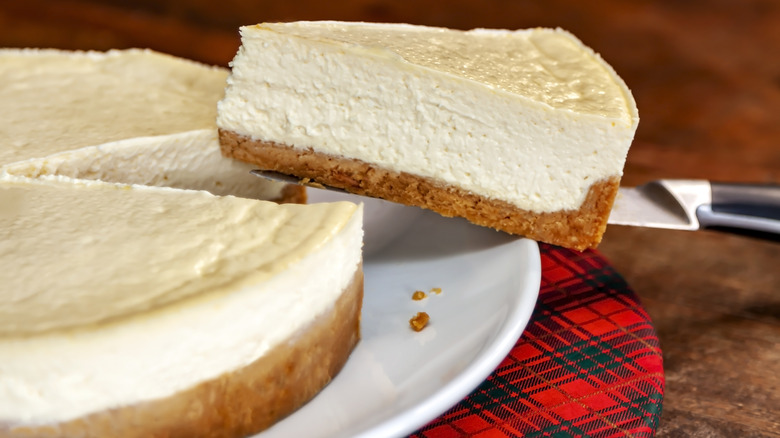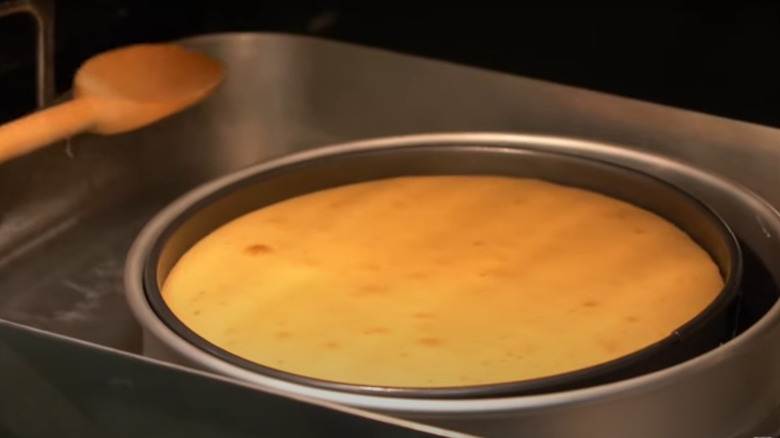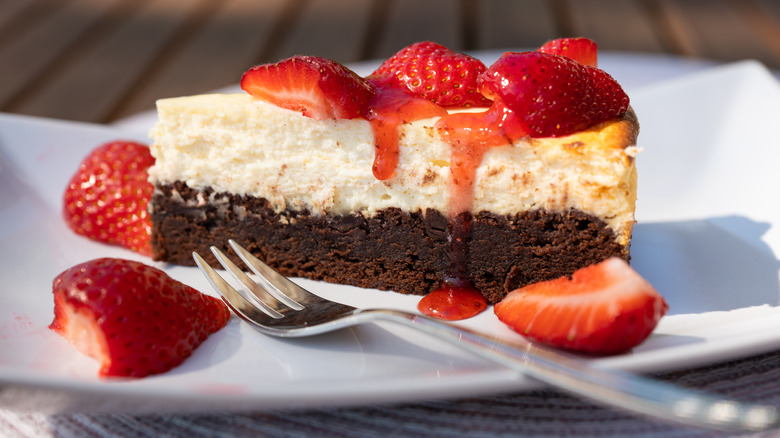Prevent Over-Baked Cheesecake With A Clever Wooden Spoon Test
The soft and creamy texture of cheesecake paired with its sweet flavor makes this dessert a delight to enjoy after a hearty meal. The fact that there are so many types of cheesecakes with countless flavor variations just adds to its decadence. Though the process of making cheesecake is relatively straightforward, it can get a little finicky when determining when it's ready to pull out of the oven so it doesn't over-bake. This is where we recommend the wobble test.
Also known as the jiggle test, this clever trick uses a wooden spoon to assess whether the inside of the cheesecake is well-cooked. The first step, after you've popped the cheesecake batter in the oven, is to set your timer a few minutes shy of the actual cooking time. When the timer goes off open the oven door and with the wooden spoon in your dominant hand, tap the side of the springform baking pan lightly and observe how the cheesecake behaves.
If you see ripples and the batter jiggling outrightly, that means the cheesecake is still too wet inside hence needs a bit more time to cook through. If when tapping the pan, you see a slight wobble mostly from the very center of the cheesecake and notice that the outer parts of the cake have set, then it's ready. Any more time cooking and it'll over-bake, so turn off the oven and allow your dessert to cool while inside the oven before removing it.
Why the wooden stick test works
If you're more familiar with baking regular cakes, you may wonder why we're aiming for a wobbly cheesecake to determine doneness instead of a fully set batter as is the case with regular cake. Well, it's because these are different dishes. In actual sense, cheesecake isn't even a real cake, and when perfectly made, it has a creamy, silky consistency, not the crumbly texture of a regular cake. In order to achieve this custardy texture, cheesecake must be pulled out of the oven when it's still a bit soft on the inside, and that's where the wobble test comes in.
Being able to identify when the batter is semi-fluid and not fully set is the essence of this jiggle test, and it works if performed at the right time. So if you tap the side of the baking pan and the cheesecake doesn't move at all, that means you waited too long and your cheesecake is unfortunately over-baked. You can still eat it, but it won't be the luscious dessert we know and love. So ensure you perform the wobble test before the cooking time indicated on your recipe is up so you don't risk an over-baked treat.
Alternative way to tell if your cheesecake is done
If you're not confident about performing the wooden spoon test or just want another method to add to your arsenal of testing your cheesecake's doneness, we've got you. Try checking the internal temperature of the cheesecake. The good thing about this method is that it's completely objective since you're reading the exact temperature of the baked good using a thermometer and not depending on your subjective interpretation of a test. Moreover, checking the temperature is a sure way of knowing your cheesecake is cooked through and therefore safe to eat. The internal temperature to aim for is 150 degrees Fahrenheit. Just stick a probe thermometer in the middle of the cheesecake and look at the readings.
The only drawback is that after you pull out the probe, you'll have a tiny hole left in the middle of the cheesecake. This will affect the aesthetics of the baked good. So if you have to go this route of checking the temperature, be prepared to add toppings to your cheesecake to cover up that little defect. Either way, it's better to have a well-cooked, delicious cheesecake with a small aesthetic defect than an over-baked one that no one will want to eat.


